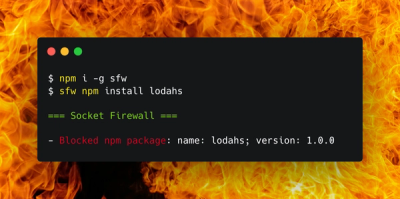
Security News
PodRocket Podcast: Inside the Recent npm Supply Chain Attacks
Socket CEO Feross Aboukhadijeh discusses the recent npm supply chain attacks on PodRocket, covering novel attack vectors and how developers can protect themselves.
This gem aims at being a simple and reliable solution for controlling external programs running in the background on any Ruby / OS combination.
The code originated in the selenium-webdriver gem, but should prove useful as a standalone library.
The object returned from ChildProcess.build will implement ChildProcess::AbstractProcess.
process = ChildProcess.build("ruby", "-e", "sleep")
# inherit stdout/stderr from parent...
process.io.inherit!
# ...or pass an IO
process.io.stdout = Tempfile.new("child-output")
# modify the environment for the child
process.environment["a"] = "b"
process.environment["c"] = nil
# set the child's working directory
process.cwd = '/some/path'
# start the process
process.start
# check process status
process.alive? #=> true
process.exited? #=> false
# wait indefinitely for process to exit...
process.wait
process.exited? #=> true
# get the exit code
process.exit_code #=> 0
# ...or poll for exit + force quit
begin
process.poll_for_exit(10)
rescue ChildProcess::TimeoutError
process.stop # tries increasingly harsher methods to kill the process.
end
r, w = IO.pipe
begin
process = ChildProcess.build("sh" , "-c",
"for i in {1..3}; do echo $i; sleep 1; done")
process.io.stdout = w
process.start # This results in a subprocess inheriting the write end of the pipe.
# Close parent's copy of the write end of the pipe so when the child
# process closes its write end of the pipe the parent receives EOF when
# attempting to read from it. If the parent leaves its write end open, it
# will not detect EOF.
w.close
thread = Thread.new do
begin
loop do
print r.readpartial(16384)
end
rescue EOFError
# Child has closed the write end of the pipe
end
end
process.wait
thread.join
ensure
r.close
end
Note that if you just want to get the output of a command, the backtick method on Kernel may be a better fit.
process = ChildProcess.build("cat")
out = Tempfile.new("duplex")
out.sync = true
process.io.stdout = process.io.stderr = out
process.duplex = true # sets up pipe so process.io.stdin will be available after .start
process.start
process.io.stdin.puts "hello world"
process.io.stdin.close
process.poll_for_exit(exit_timeout_in_seconds)
out.rewind
out.read #=> "hello world\n"
search = ChildProcess.build("grep", '-E', %w(redis memcached).join('|'))
search.duplex = true # sets up pipe so search.io.stdin will be available after .start
search.io.stdout = $stdout
search.start
listing = ChildProcess.build("ps", "aux")
listing.io.stdout = search.io.stdin
listing.start
listing.wait
search.io.stdin.close
search.wait
By default, the child process does not create a new process group. This means there's no guarantee that the entire process tree will die when the child process is killed. To solve this:
process = ChildProcess.build(*args)
process.leader = true
process.start
process = ChildProcess.build("sleep", "10")
process.detach = true
process.start
As opposed to Kernel#system, Kernel#exec et al., ChildProcess will not automatically execute your command in a shell (like /bin/sh or cmd.exe) depending on the arguments.
This means that if you try to execute e.g. gem executables (like bundle or gem) or Windows executables (with .com or .bat extensions) you may see a ChildProcess::LaunchError.
You can work around this by being explicit about what interpreter to invoke:
ChildProcess.build("cmd.exe", "/c", "bundle")
ChildProcess.build("ruby", "-S", "bundle")
Errors and debugging information are logged to $stderr by default but a custom logger can be used instead.
logger = Logger.new('logfile.log')
logger.level = Logger::DEBUG
ChildProcess.logger = logger
ENV["PATH"] before using childprocess could lead to 'Command not found' errors, since JRuby is unable to modify the environment used for PATH searches in java.lang.ProcessBuilder. This can be avoided by setting ChildProcess.posix_spawn = true.--add-opens java.base/java.io=org.jruby.dist and --add-opens java.base/sun.nio.ch=org.jruby.dist to the JAVA_OPTS environment variable that is used by JRuby when launching the JVM.ChildProcess 5+ uses Process.spawn from the Ruby core library for maximum portability.
git checkout -b my-new-feature devgit commit -am 'Add some feature'git push origin my-new-featureWhen publishing a new gem release:
dev branchdev branch into master: git checkout master && git merge devmaster branchmaster branch: git checkout master && gem build childprocess.gemspecgem push childprocess-<VERSION>.gemgit tag -a <VERSION>Copyright (c) 2010-2015 Jari Bakken. See LICENSE for details.
FAQs
Unknown package
We found that childprocess demonstrated a not healthy version release cadence and project activity because the last version was released a year ago. It has 3 open source maintainers collaborating on the project.
Did you know?

Socket for GitHub automatically highlights issues in each pull request and monitors the health of all your open source dependencies. Discover the contents of your packages and block harmful activity before you install or update your dependencies.

Security News
Socket CEO Feross Aboukhadijeh discusses the recent npm supply chain attacks on PodRocket, covering novel attack vectors and how developers can protect themselves.

Security News
Maintainers back GitHub’s npm security overhaul but raise concerns about CI/CD workflows, enterprise support, and token management.

Product
Socket Firewall is a free tool that blocks malicious packages at install time, giving developers proactive protection against rising supply chain attacks.